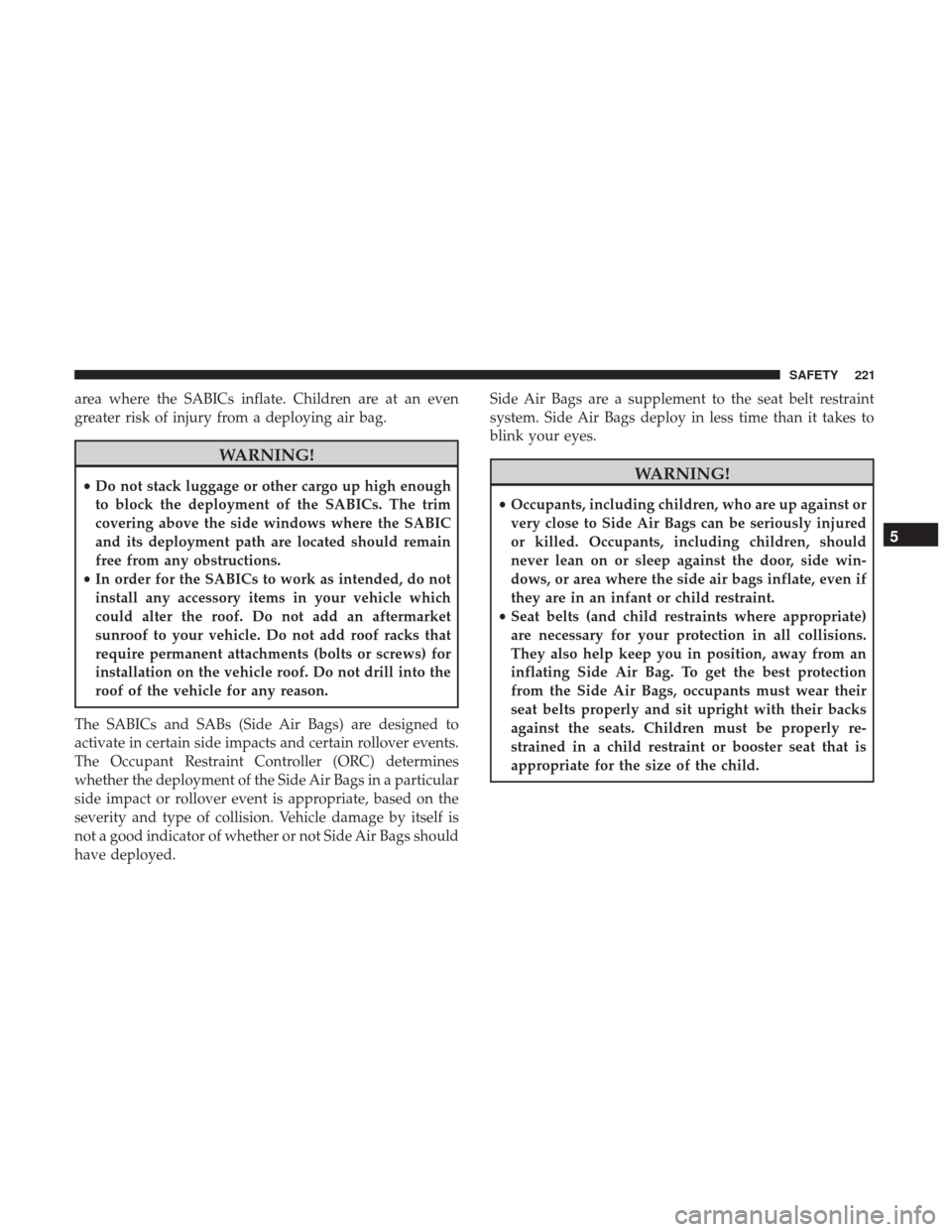Page 20 of 516
▫Cargo Area Features .....................102
� INTERNAL EQUIPMENT ..................109
▫ Glove Compartment .....................109
▫ Sun Visors ...........................110
▫ Power Outlets .........................111
▫ Power Inverter — If Equipped .............113
▫ Cigar Lighter — If Equipped ...............114 ▫
Ashtray — If Equipped ...................115
▫ Front Armrest .........................116
▫ Cupholders ...........................117
▫ Handle Grip ..........................118
� ROOF LUGGAGE RACK — IF EQUIPPED ......118
18 GETTING TO KNOW YOUR VEHICLE
Page 120 of 516

Handle Grip
The handle grip is located on the passenger side of the
instrument panel. The handle can be used to enter or exit
the vehicle or when traveling on rough terrain.
ROOF LUGGAGE RACK — IF EQUIPPED
Your vehicle may be equipped with a Roof Luggage Rack
for transporting accessories.
Crossbars should always be used whenever cargo is placed
on the Roof Luggage Rack. Check the straps frequently to
be sure that the load remains securely attached.
NOTE:Crossbars can be purchased at a authorized dealer
through Mopar parts. External racks do not increase the
total load carrying capacity of the vehicle. Be sure that the
total occupant and luggage load inside the vehicle, plus the
load on the Roof Luggage Rack, do not exceed the maxi-
mum vehicle load capacity.
The load carried on the roof, when equipped with a
luggage rack, must not exceed 150 lbs (68 kg), and it should
be uniformly distributed over the cargo area.
Do not use the retractable roof when using the crossbars.
Handle Grip
118 GETTING TO KNOW YOUR VEHICLE
Page 121 of 516

WARNING!
Cargo must be securely tied down before driving your
vehicle. Improperly secured loads can fly off the ve-
hicle, particularly at high speeds, resulting in personal
injury or property damage. Follow the roof rack cau-
tions when carrying cargo on your roof rack.
CAUTION!
•To avoid damage to the roof rack and vehicle, do not
exceed the maximum roof rack load capacity. Always
distribute heavy loads as evenly as possible and
secure the load appropriately.
• Long loads, which extend over the windshield, such
as wood panels or surfboards, should be secured to
both the front and rear of the vehicle.
• Place a blanket or other protection between the
surface of the roof and the load.
• Travel at reduced speeds and turn corners carefully
when carrying large or heavy loads on the roof rack.
Wind forces, due to natural causes or nearby truck
(Continued)
CAUTION! (Continued)
traffic, can add sudden upward loads. This is espe-
cially true on large flat loads and may result in
damage to the cargo or your vehicle.
• Load should always be secured to cross bars first,
with tie down loops used as additional securing
points if needed. Tie loops are intended as supple-
mentary tie down points only. Do not use ratcheting
mechanisms with the tie loops. Check the straps
frequently to be sure that the load remains securely
attached.
3
GETTING TO KNOW YOUR VEHICLE 119
Page 223 of 516

area where the SABICs inflate. Children are at an even
greater risk of injury from a deploying air bag.
WARNING!
•Do not stack luggage or other cargo up high enough
to block the deployment of the SABICs. The trim
covering above the side windows where the SABIC
and its deployment path are located should remain
free from any obstructions.
• In order for the SABICs to work as intended, do not
install any accessory items in your vehicle which
could alter the roof. Do not add an aftermarket
sunroof to your vehicle. Do not add roof racks that
require permanent attachments (bolts or screws) for
installation on the vehicle roof. Do not drill into the
roof of the vehicle for any reason.
The SABICs and SABs (Side Air Bags) are designed to
activate in certain side impacts and certain rollover events.
The Occupant Restraint Controller (ORC) determines
whether the deployment of the Side Air Bags in a particular
side impact or rollover event is appropriate, based on the
severity and type of collision. Vehicle damage by itself is
not a good indicator of whether or not Side Air Bags should
have deployed. Side Air Bags are a supplement to the seat belt restraint
system. Side Air Bags deploy in less time than it takes to
blink your eyes.WARNING!
•
Occupants, including children, who are up against or
very close to Side Air Bags can be seriously injured
or killed. Occupants, including children, should
never lean on or sleep against the door, side win-
dows, or area where the side air bags inflate, even if
they are in an infant or child restraint.
• Seat belts (and child restraints where appropriate)
are necessary for your protection in all collisions.
They also help keep you in position, away from an
inflating Side Air Bag. To get the best protection
from the Side Air Bags, occupants must wear their
seat belts properly and sit upright with their backs
against the seats. Children must be properly re-
strained in a child restraint or booster seat that is
appropriate for the size of the child.
5
SAFETY 221